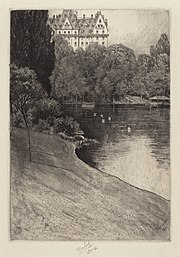The New York Etching Club, formally New York Etchers Club, [1] was one of the earliest professional organization in America devoted to the medium of etching. [2] [3] Its founders were inspired by the Etching revival that had blossomed in France and England in the middle of the 19th century. [4] The purpose of the club was to create and promote etchings that did not merely reproduce existing paintings, but were original creations of art in their own right. [5]
History
The first meeting of the New York Etchers Club took place in the studio of James David Smillie on May 2, 1877. [1] An etching by Robert Swain Gifford was printed on a small press under the supervision of Dr. Leroy Milton Yale Jr. [5] Eventually, bi-monthly meetings moved to the studio of Henry Farrer where etchings were printed from a press that Farrer built.[ citation needed] The club was formed by Dr. Yale, Robert Swain Gifford and James David Smillie, with Yale as its first President. [6]
Other important members of the New York Etching Club included Charles Adams Platt, Thomas Moran, Samuel Colman, Kruseman Van Elten, William Merritt Chase, Frederick Stuart Church, Stephen Parrish, Joseph Pennell, J. C. Nicoll, Charles Frederick William Mielatz, and Thomas Waterman Wood. [7] For most members, etching was an important side-interest to their main occupation as painters. [8] [9] That was not the case, however, for Edith Loring Getchell and Mary Nimmo Moran, two other artists of note who were both primarily etchers. [10]
The New York Etching Club held regular exhibitions through the early 1890s in which members and invited guests displayed their etchings for sale to the general public. From 1879 to 1881, works by members of the New York Etching Club were also featured in a periodical called The American Art Review. [11] Published under the leadership of Sylvester Rosa Koehler, the first curator of prints at the Museum of Fine Arts, Boston, it further popularized etching as a medium and the New York Etching Club as a professional organization. The success of the New York Etching Club helped spawn similar organizations in other major American cities in the late 19th century. [12]
See also
References
- ^ a b Peters, Lisa (1982). "Print Clubs in America". The Print Collector's Newsletter. 13 (3): 88–91. ISSN 0032-8537. JSTOR 44131087.
- ^ "New York Etching Club". Smithsonian American Art Museum (SAAM). Retrieved 2021-08-19.
- ^ "American Etchers Abroad, 1880-1939". www.tfaoi.com. Brandywine River Museum. 2006. Retrieved 2021-08-19.
- ^ Schneider, Rona. “The American Etching Revival: Its French Sources and Early Years.” American Art Journal 14, no. 4 (1982): 40–65. doi: 10.2307/1594318.
- ^ a b E. T. L. “The New York Etching Club.” The Art Journal (1875-1887) 6 (1880): 186–87. doi: 10.2307/20569534.
- ^ Yale Family Collection and Artwork Collection, Woods Hole Historical Museum Archives, 1802-2009, p. 2
- ^ "THE FINE ARTS.; NEW-YORK ETCHING CLUB". The New York Times. Retrieved 2021-11-29.
- ^ Marantz Cohen, Paula (January 23, 2015). "Stumbling on the sublime". The Smart Set. Retrieved August 8, 2017.
- ^ TURNER, SIMON, ANTONY GRIFFITHS, HENRI ZERNER, RUTH BROMBERG, GIORGIO MARINI, ROBERT A. GERARD, JÜRGEN DÖRING, et al. “Notes.” Print Quarterly 16, no. 4 (1999): 370–92. JSTOR 41824992.
- ^ "New York Etching Club (Worldcat Identities)". Worldcat Identities. Retrieved Nov 28, 2021.
- ^ "OpenStax CNX". cnx.org. Retrieved 2021-11-29.
- ^ Breitenbach, Edgar. “American Graphics in the Late Nineteenth Century.” Archives of American Art Journal 30, no. 1/4 (1990): 19–26. JSTOR 1557637.
